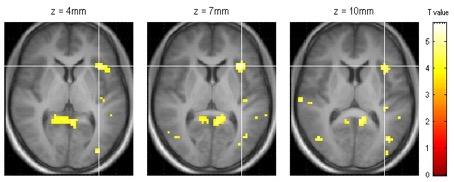Just add water? New MRI technique shows what drinking water does to your appetite, stomach and brain

Activation in the insula is increased when the stomach is distended more. Credit: Authors: G CAMPS, R VEIT, M MARS, C DE GRAAF, P SMEETS
Stomach MRI images combined with functional fMRI of the brain activity have provided scientists new insight into how the brain listens to the stomach during eating. Research from Wageningen University in the Netherlands shows – for the first time – real time data of the brain, the stomach, and people's feelings of satiety measured simultaneously during a meal, in a study to be reported this week at the annual meeting of the Society for the Study of Ingestive Behavior, held in Porto, Portugal. The researchers collected data from 19 participants during two separate sessions with different consumption procedures and found that a simple change like drinking more water can alter messages from the stomach interpreted as fullness by the brain. This new research approach can be used to investigate the interplay between satiety feelings, volume of the stomach and activity in the brain.
In the experiment, participants drank a milk-shake on an empty stomach, which was followed by a small (50 mL) or large glass of water (350 mL). MRI images were used to see how the different amounts of water affected stretching of the stomach: the large glass of water doubled the stomach content compared to the small glass. Together with this larger volume subjects reported to have less hunger and felt fuller.
This novel approach – combining information obtained simultaneously from MRI images of the stomach, feelings reported by the subjects, and brain scans – can offer new insights which would otherwise have been unknown, for example that activation in a brain area called the mid-temporal gyrus seems is in some way influenced by the increased water load in this experiment. The Wageningen University scientists developed the combined MRI method as part of the European Nudge-it research project, which seeks to discover simple changes that promote healthier eating. They will use it to search for a brain signature that leads people to decide to stop eating, to determine how strategies like water with a meal can be effective at feeling fuller sooner.
“Combining these types of measurements is difficult, because MRI scanners are usually set-up to perform only one type of scan. We've been able to very quickly switch the scanner from one functionality to another to do this type of research” says Guido Camps, lead author of the study. “In conclusion, we've found that simply adding water increases stomach distension, curbs appetite in the short term and increases regional brain activity.”
###
Figure 1.
Activation in the insula is increased when the stomach is distended more.
Figure 2.
The same subject with either the small (left) or large volume of water (right) in the stomach (delineated in red).
Research: “Just add water: how water affects gastric distension, appetite and brain activity”
Authors:
G CAMPS, R VEIT, M MARS, C DE GRAAF, P SMEETS
Media Contact
All latest news from the category: Social Sciences
This area deals with the latest developments in the field of empirical and theoretical research as it relates to the structure and function of institutes and systems, their social interdependence and how such systems interact with individual behavior processes.
innovations-report offers informative reports and articles related to the social sciences field including demographic developments, family and career issues, geriatric research, conflict research, generational studies and criminology research.
Newest articles

Silicon Carbide Innovation Alliance to drive industrial-scale semiconductor work
Known for its ability to withstand extreme environments and high voltages, silicon carbide (SiC) is a semiconducting material made up of silicon and carbon atoms arranged into crystals that is…

New SPECT/CT technique shows impressive biomarker identification
…offers increased access for prostate cancer patients. A novel SPECT/CT acquisition method can accurately detect radiopharmaceutical biodistribution in a convenient manner for prostate cancer patients, opening the door for more…

How 3D printers can give robots a soft touch
Soft skin coverings and touch sensors have emerged as a promising feature for robots that are both safer and more intuitive for human interaction, but they are expensive and difficult…





















